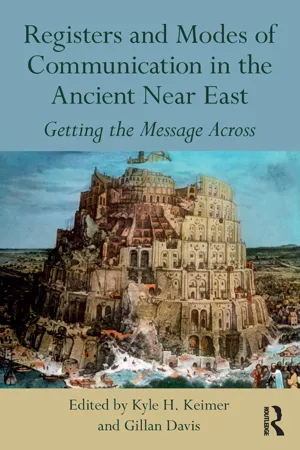This first section contains chapters that deal with communications by royal courts, elites, and/or that attest to the impact of royal/imperial power on the ways communications were manifest in antiquity. While drawing upon written texts and focusing on the modes of those texts, many of the chapters in this section also consider the field and tone aspects of register. They illuminate specific linguistic instantiations and how the rationale for these is based upon practical contextual considerations.
Texts cited in this section are intended to expound elite propaganda/ideology, or are attempts by those who are not elite to become elite and/or be viewed as elite. The various inscriptions cited in the chapters in this section have a strong formality in language use.
Noel Weeks’ chapter on The disappearance of cuneiform from the west and elites in the ancient Near East addresses the question of how cuneiform was adopted and abandoned in areas outside of its Mesopotamian homeland as a particular mode of elite discourse. In particular, he asks, “was it that something came with the cuneiform script and Akkadian that was not otherwise available, or was there something in the character of the Mesopotamian writing system which gave it a practical advantage?” In considering the appearance of cuneiform in Anatolia and the Levant he considers the role of trade, technical expertise, and elite demands, noting that the reasons for the use and replacement of cuneiform as an international script are multivariant and subjective. He suggests that the various reasons are tied to human opportunity and the durability of the medium upon which cuneiform was typically inscribed; the context of each situation must be considered if we are to understand what was being written with cuneiform, when it was being written, by whom, and for what purpose.
In Contrasting representations and the Egypto-Hittite treaty, Sam Jackson breaks down the differences in the Egyptian and Hittite versions of their treaty following the battle of Kadesh. He articulates the different purposes of Egyptian and Hittite historiography and text production and touches on what systemic functional linguistics would consider the field and tenor of the two copies of the treaty. In doing so, Jackson is able to parcel out various factors – be they cultural or ideological – that influenced the specific language choices in the Egyptian version of the treaty in particular. Further, his chapter highlights the tension between the registers of language we see in Egyptian monumental inscriptions versus royal correspondences.
Luis Siddall’s chapter on Text and context: the question of audience for Sennacherib’s ‘public’ inscriptions, indicates that the search for ancient audiences of written texts is not in vain. While they may not be always easy to identify, careful consideration of the context and tone of a given text may make it possible. He demonstrates that an ancient text could have multiple audiences in mind, including, remarkably, just the king himself and the rulers to follow. The audiences could even have imbued multiple meanings to the same text, despite any overarching ideology. Further, texts of the same genre can provide specific details meant to be read/understood/interpreted in very contextually-specific circumstances.
Wayne Horowitz’s Communication and miscommunication in the southern sky: the case of Scorpio and the Southern Cross in cuneiform explicitly discusses how we today communicate with ancient texts. Messages, he notes, are preserved in text and can be understood through an understanding of the context not only of the text itself, but also the implied context – per reader response theory – within a given text. He uses three case studies in the identification of ancient Mesopotamian star/constellation names to highlight how a proper understanding of context allows us to correct previous interpretations, and even to communicate with long dead authors.
In Imperialism and language: observations on bilingual inscriptions from Palmyra, Samuel Lieu notes that Palmyra’s economic standing led to imperial interaction at the site, including the appearance and appropriation of Greek as a prestige language over the local Aramaic. The shift of written language through the impact of imperial presence, and the local attempts to identity or de-identify with that power are highlighted through a detailed assessment of the content of each language in select bilingual inscriptions from the site. Lieu articulates why various authors included the information they did in each given language, identifying each author’s field and tone of communication, and shedding light on the mode of the given text. Lieu’s chapter includes an appendix of every dated Palymrene bilingual and trilingual inscription, including those from Dura Europas.
